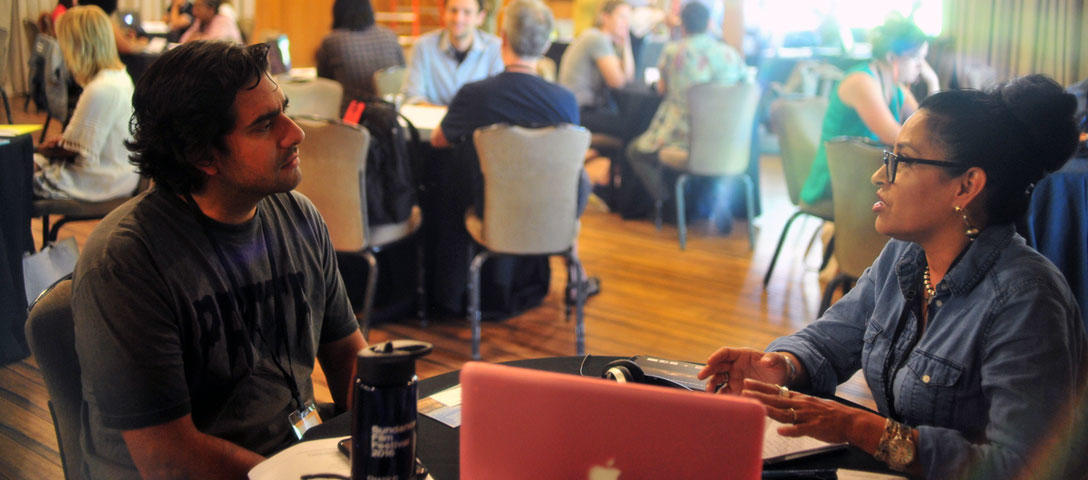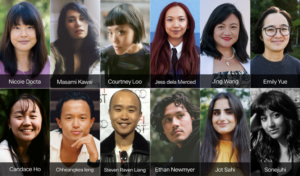Jhane Myers (right) at the 2017 Creative Producing Lab & Summit. © 2017 Sundance Institute | Jonathan Hickerson
Jhane Myers
Growing up in rural Oklahoma and raised as an elders’ child by my grandparents, I always went eagerly to see any movie that seemed to have something to do with Native people. And as I left the theater, my Comanche grandfather always said, disappointedly, the same remark: “Maybe someday they will get it right.” As a little Indian girl, I wondered if and how Hollywood would ever get the message.
As a little Indian girl, I wondered if and how Hollywood would ever get the message.
—Jhane Myers
Native people always seemed to be invisible and few in the film industry. We frequently see romanticized and inaccurate decisions made on our behalf and in our absence. I recall a conversation with the outspoken and amazing Native advocate Suzan Shown Harjo (Cheyenne, Hodulgee Muscogee) where she proudly proclaimed, “Hollywood discovers Indians every 20 years, and we have always been here.”
Being a proud Southern and Northern Plains Indian woman from the Nations of the Comanche and Blackfeet people, my ties are to the rich tribal histories, culture, and language that lend to so many untold stories of the strength of Native people. From being an editor-in-chief for my own entertainment magazine in Oklahoma to opening a public relations firm that dealt exclusively in Native community and tribal relations, everything I have done in my life to this point has prepared me for that next step in my career.
I was an associate producer on the Sundance documentary project of my Comanche relative La Donna Harris, a role model and iconic stateswoman who has historically and globally influenced so many Native communities and Indigenous people. My Comanche language skills also had me translating and dialect-coaching Martin Sensmeir (Tlingit, Koyukon-Athebascan) and Academy Award winner Denzel Washington in Magnificent Seven.
The film was released during our annual Comanche Nation Fair, and amid the hot Oklahoma weather, Comanches sought refuge in the cool, dark theaters. Much to their surprise, Denzel graced the screen speaking Comanche. “Wait, Denzel just spoke Comanche and I didn’t have to read the subtitles because I understood him?” The word spread like wildfire, and my people proudly posted on Facebook on how great it was to hear our language.
I know that the industry needs more Native producers, and especially more Native women producers, so I jumped at the chance to apply for the Time Warner Native Producing fellowship last year. My project is one that makes significant barrier changes in every step of the production. As a producer, I shared the vision of director Jeffrey Palmer (Kiowa) on how to make the N. Scott Momaday (Kiowa) documentary Words from a Bear a Native game changer. We have a 90% Native crew, and we’ve used five Sundance Institute Native Program fellows on our production team.
My personal cultural philosophy mirrors the Native Program’s philosophy: For four years, I have been the director of the Sundance-supported Museum of Indian Arts and Culture Native Youth Film Camp, which teaches Native students ages 14-to-18 script-to-screen skills as they make 6-to-8 short films per camp. The students take their newly learned skills back to their tribal communities, pueblos, and reservations to produce their own family and tribal stories.
Seeing the stories and creativity that come out of the Native youth film camp, I can still hear my grandfather saying “When are they going to get it right?” And my answer is, “We are getting it right!”
Jhane Myers (Comanche, Blackfeet) was a 2017 Time Warner Native Producing Fellow. The program supports U.S.-based Native producers in their professional development and the advancement of their projects.




